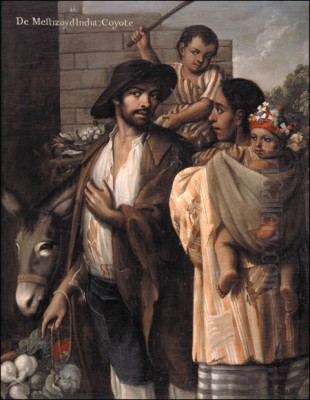
Miguel Mateo Maldonado y Cabrera (1695–1768) stands as one of the most significant and prolific painters of the Viceroyalty of New Spain, roughly corresponding to modern-day Mexico. Flourishing in the mid-18th century, his career represents a high point of the Baroque style as it was adapted and transformed in the Americas. Cabrera's vast output encompassed religious altarpieces, devotional images, allegorical scenes, portraits, and the unique genre of Casta paintings, reflecting the complex social and cultural milieu of his time. His influence extended beyond his own canvases, as he played a crucial role in the professionalization of art through the establishment of a painting academy in Mexico City.
Origins and Cultural Identity
Born in 1695 in Antequera, now Oaxaca, a city in southern New Spain known for its rich indigenous heritage and colonial architecture, Miguel Cabrera's background reflected the mestizaje, or cultural and ethnic mixing, that characterized the region. It is widely documented that his father was Spanish, and his mother was a native Zapotec woman from Oaxaca. This mixed heritage placed him within the complex social hierarchy of the colony, yet it also potentially provided him with a unique perspective, bridging European artistic traditions with American realities.
Despite his indigenous maternal lineage, Cabrera, like many successful individuals of mixed ancestry in the colonial period, appears to have emphasized his Spanish heritage throughout his professional life. This was often a pragmatic necessity for social and economic advancement within a system that privileged European lineage. He moved from Oaxaca to Mexico City, the vibrant administrative and cultural heart of New Spain, early in his career. It was here that he would establish his reputation, gain powerful patrons, and create the body of work that secured his legacy.
Artistic Formation and Influences
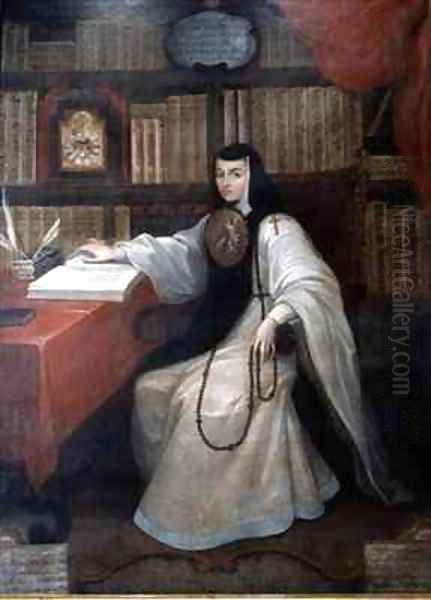
Details about Cabrera's formal artistic training remain somewhat scarce, as was common for artists of that era. It is highly probable that he learned his craft through an apprenticeship system prevalent in Mexico City, likely working in the studio of established masters. While the specific names of his teachers are debated, the influence of earlier generations of New Spanish painters, such as the celebrated Cristóbal de Villalpando (c. 1649–1714) and Juan Correa (c. 1646–1716), is discernible in the grandeur and compositional complexity found in some of Cabrera's larger works.
However, the most profound stylistic influences on Cabrera came directly from Europe, particularly the Spanish Baroque masters. The impact of Bartolomé Esteban Murillo (1617–1682) is undeniable. Murillo's soft modeling of figures, idealized depictions of the Virgin Mary and saints, and emotionally resonant religious scenes find echoes throughout Cabrera's oeuvre. Cabrera often adopted Murillo's gentle piety and graceful compositions, adapting them to the tastes and devotional needs of his New Spanish clientele.
The influence of Francisco de Zurbarán (1598–1664) can also be detected, particularly in the solemnity and intense realism found in some of Cabrera's depictions of saints and monastic figures. Zurbarán's mastery of chiaroscuro (the dramatic use of light and shadow) and his ability to convey profound spirituality through stark simplicity may have informed Cabrera's approach to certain subjects. Furthermore, the broader tradition of Spanish Golden Age painting, including the realism of Diego Velázquez (1599–1660), likely formed part of the visual vocabulary available to an ambitious painter like Cabrera through prints and imported works.
Intriguingly, some scholars also point to the influence of French Rococo aesthetics, possibly transmitted through prints or the presence of European artists. The elegance, lighter palette, and decorative sensibility associated with artists like Jean-Antoine Watteau (1684–1721) or even François Boucher (1703-1770) might be reflected in the refined details and graceful postures seen in some of Cabrera's secular portraits and mythological scenes, suggesting his awareness of evolving European tastes.
Dominance in Religious Painting
The Catholic Church was the single most important patron of the arts in colonial New Spain, and Miguel Cabrera became one of its most favored painters. He received numerous commissions from various religious orders, including the Jesuits, Dominicans, and Franciscans, as well as from high-ranking clergy and wealthy private citizens seeking devotional images for their homes. His workshop produced a vast number of canvases depicting the life of Christ, the Virgin Mary, and a wide array of saints, destined for churches, convents, and private chapels throughout the viceroyalty.
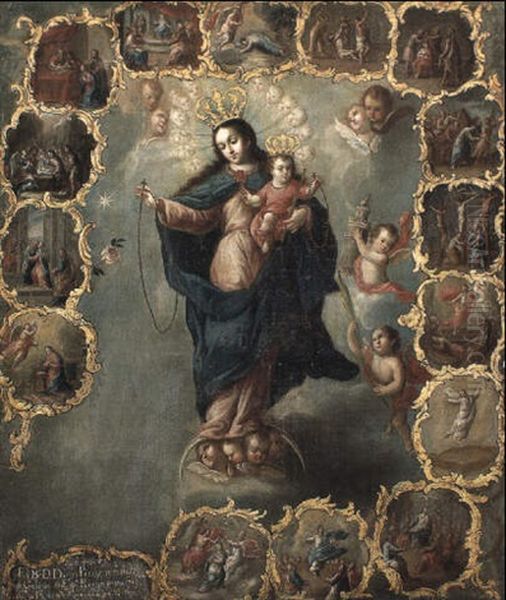
Cabrera excelled in creating large-scale altarpieces, complex narrative scenes filled with figures, rich colors, and dramatic lighting, designed to inspire awe and piety in the viewer. His depictions of the Virgin Mary were particularly sought after, ranging from grand representations of the Immaculate Conception to tender images of the Madonna and Child. He demonstrated a remarkable ability to convey both divine majesty and human tenderness, qualities that resonated deeply with the religious sensibilities of the time.
His close relationship with the Jesuit order was particularly significant. He produced numerous works for their institutions, including depictions of Jesuit saints like St. Ignatius of Loyola and St. Francis Xavier. One notable example often attributed to his circle or directly to him is The Allegory of the Sacred Heart of Jesus, a theme heavily promoted by the Jesuits, showcasing his ability to translate complex theological concepts into compelling visual form.
Cabrera's connection to Archbishop Manuel José Rubio y Salinas further solidified his position. He served as the Archbishop's preferred painter, undertaking significant commissions, including portraits and important religious works. This patronage undoubtedly opened doors and enhanced his prestige within both ecclesiastical and secular circles.
The Virgin of Guadalupe and Maravilla americana
Perhaps Cabrera's most famous association with religious imagery involves the Virgin of Guadalupe, the patron saint of Mexico. In 1751, Cabrera was part of a group of prominent painters invited to examine the original miraculous image imprinted on the tilma (cloak) of Juan Diego. This examination aimed to assess the image's physical nature and potentially authenticate its divine origin.
Following this inspection, Cabrera, along with other artists like José de Ibarra (1685–1756), provided expert testimony. Cabrera went further, publishing a treatise in 1756 titled Maravilla americana y conjunto de raras maravillas observadas con la dirección de las reglas del arte de la pintura (American Marvel and Ensemble of Rare Wonders Observed with the Guidance of the Rules of the Art of Painting). In this text, he meticulously analyzed the Guadalupe image from an artist's perspective, arguing that its execution defied known painting techniques and materials, thus supporting the belief in its miraculous creation.
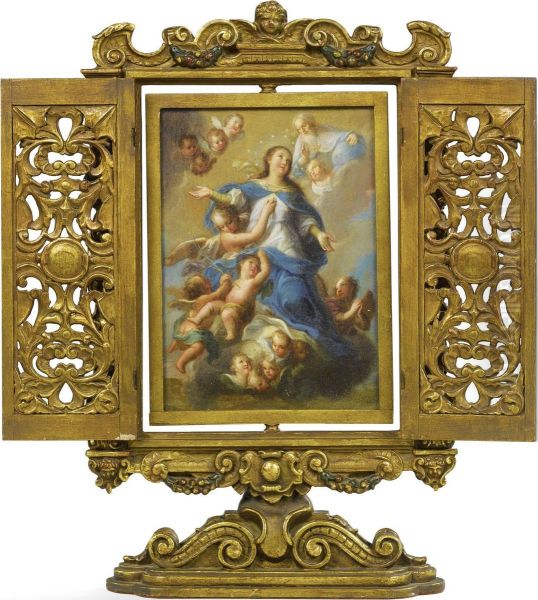
He praised the image's four distinct painting techniques (oil, tempera, watercolor, and fresco or labrado) allegedly found on the coarse fabric, the perfection of the drawing, the harmonious coloring, and the durability of the image over centuries. While modern analysis offers different explanations, Cabrera's Maravilla americana was highly influential in its time, lending artistic authority to the Guadalupe devotion and cementing Cabrera's reputation as not just a skilled painter but also a learned expert. He subsequently painted numerous copies and interpretations of the Virgin of Guadalupe, which were highly sought after.
The Art of the Casta Painting
Beyond religious art, Miguel Cabrera made significant contributions to the genre known as Casta painting (pinturas de castas). These unique series of paintings, typically consisting of sixteen panels, aimed to document and classify the complex process of racial mixing (mestizaje) occurring between the three main population groups in the colony: Indigenous peoples (Indios), Europeans (Españoles), and Africans (Negros). Each panel typically depicted a couple of different racial backgrounds with their offspring, labeled with the specific term assigned to that particular mixture (e.g., Mestizo, Castizo, Mulatto, Morisco, Albino).
Cabrera's Casta series, created around 1763, is considered one of the finest examples of the genre. While Casta paintings often served the colonial elite's desire to impose order and hierarchy on a fluid social reality, Cabrera's interpretations stand out for their artistic quality, detailed observation, and sympathetic portrayal of the figures. Unlike the sometimes stereotypical or rigid depictions by other Casta painters like Juan Rodríguez Juárez (1675–1728) or José de Páez (1720–1790), Cabrera imbued his figures with a sense of dignity and individuality.
His compositions are carefully arranged, often set in detailed domestic or occupational settings, providing glimpses into the daily lives, clothing, and activities associated with different social strata. Works like De español y albina, Torna atrás (From Spaniard and Albino Woman, Return Backwards) or De Español y Morisca, Albino (From Spaniard and Morisca Woman, Albino) showcase his skill in rendering diverse physiognomies, rich textiles, and expressive interactions between family members. While reflecting the racial classifications of the era, Cabrera's Casta paintings also offer invaluable visual documentation of the diverse society of 18th-century New Spain.
Portraiture and Secular Works
Miguel Cabrera was also an accomplished portraitist, capturing the likenesses of prominent figures within New Spanish society. His portraits often combined meticulous attention to detail in clothing and accessories – indicators of status and wealth – with a sensitive rendering of the sitter's features and personality. His patrons included viceroys, archbishops, wealthy merchants, and intellectuals.
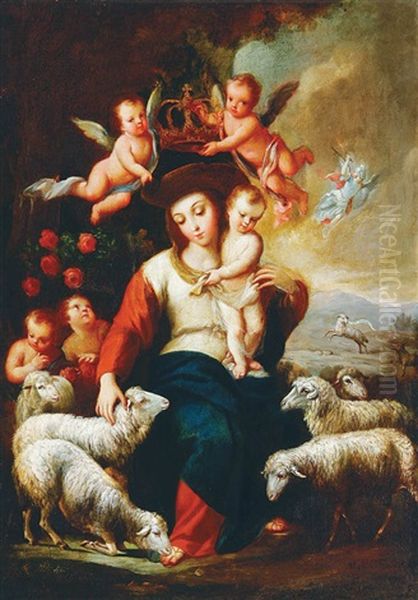
His most famous portrait is arguably the posthumous depiction of Sor Juana Inés de la Cruz (1648–1695), the renowned Hieronymite nun, poet, and scholar. Painted around 1750, decades after Sor Juana's death, Cabrera based his work on earlier portraits. He depicted her seated in her library, surrounded by books, wearing the habit of her order and the traditional nun's shield (escudo de monja) on her chest. This image became the definitive representation of Sor Juana, celebrating her intellectual prowess and solidifying her status as a cultural icon of Mexico. Its enduring fame is evidenced by its reproduction on Mexican currency.
He also painted portraits of his influential patrons, such as Archbishop Rubio y Salinas, capturing their authority and position within the colonial hierarchy. While less numerous than his religious output, Cabrera's portraits demonstrate his versatility and skill in capturing individual likeness and character.
Although rarer, Cabrera also engaged with mythological and allegorical themes derived from classical European traditions. A work sometimes attributed to him or his circle, Dafne y Apolo (Daphne and Apollo), shows a departure from the solemnity of his religious works, adopting a lighter, more dynamic, and decorative style potentially influenced by French Rococo aesthetics, as mentioned earlier. Such works indicate his awareness of broader artistic trends beyond the purely religious sphere.
Workshop, Practice, and Quality
To meet the immense demand for his work, Miguel Cabrera undoubtedly operated a large and active workshop in Mexico City. This studio would have employed apprentices and assistants who helped with preparing canvases, grinding pigments, painting backgrounds, and even executing less critical parts of commissioned works under Cabrera's supervision. This workshop model was standard practice for successful European masters like Peter Paul Rubens (1577–1640) and was essential for managing large-scale projects like altarpieces or series of paintings.
The reliance on a workshop system, combined with the pressure to fulfill numerous contracts often within tight deadlines, likely contributed to the variations in quality observed across the vast body of work attributed to Cabrera. While his finest pieces demonstrate exceptional skill and refinement, others exhibit a more routine or hurried execution, possibly indicating greater involvement by workshop assistants. This variability is not unusual for highly prolific artists of the Baroque period but is an important factor in assessing his oeuvre. Despite this, his signature style and compositional formulas often remain recognizable even in workshop productions.
The Academy and the Pursuit of Professionalism
A significant aspect of Cabrera's career was his commitment to elevating the status of painting in New Spain. In 1753, he played a leading role, alongside other prominent artists like José de Ibarra, in founding an academy of painting in Mexico City. Although short-lived, this was a pioneering effort to establish formal art education based on European academic principles, moving away from the guild-based apprenticeship system. Cabrera served as the academy's president.
The academy aimed to provide structured training in drawing, anatomy, perspective, and the study of classical models, promoting painting as a liberal art rather than merely a manual craft. This initiative reflected Enlightenment ideals spreading from Europe, where institutions like the French Royal Academy of Painting and Sculpture had already been established to regulate training and enhance the social standing of artists. While Cabrera's academy eventually faltered due to lack of consistent funding and internal disagreements, its establishment marked a crucial step towards the later founding of the Academy of San Carlos in 1781, which would dominate Mexican art education for over a century. Cabrera's involvement underscored his ambition and his desire to see painters recognized for their intellectual and creative contributions.
Mature Style: Synthesis and Skill
Miguel Cabrera's mature style represents a skillful synthesis of his diverse influences. The foundation remained rooted in the Spanish Baroque, characterized by dramatic compositions, strong emotional content, rich, often dark color palettes, and the effective use of chiaroscuro to model forms and create atmosphere. His technical proficiency was considerable, particularly evident in his rendering of luxurious fabrics, intricate lace, shimmering jewels, and lifelike flesh tones.
Upon this Baroque base, Cabrera often overlaid elements of Rococo grace and elegance. This is visible in the softer modeling of figures, particularly female saints and the Virgin Mary, the fluid drapery, the occasional use of lighter, more pastel colors, and the overall sense of refinement and decorative appeal found in many of his works. He managed to blend the solemnity and grandeur of the Baroque with a gentler, more approachable sensibility that appealed to 18th-century tastes.
His compositions were typically well-balanced, often employing dynamic diagonal lines or stable pyramidal structures. He effectively managed large groups of figures in complex narrative scenes, ensuring clarity and emotional impact. While capable of grand theatricality, he could also achieve moments of quiet intimacy and profound spirituality, demonstrating remarkable versatility across different subjects and scales.
Later Life, Death, and Enduring Legacy
Miguel Cabrera remained an active and highly sought-after painter until the end of his life. He continued to receive major commissions and dominate the artistic landscape of Mexico City. He passed away in 1768 and was buried with honors in the Church of Santa Inés in Mexico City, a testament to the high esteem in which he was held.
His death marked the end of an era, often considered the culmination of the Baroque period in New Spanish painting. While subsequent artists like Francisco Antonio Vallejo (c. 1722–1785) continued working in a similar vein, the artistic landscape would soon shift towards Neoclassicism with the establishment of the Academy of San Carlos.
Nevertheless, Cabrera's legacy endured. He was remembered as the "great artist and outstanding painter" of his time, a figure who brought New Spanish painting to a level of technical excellence and expressive power comparable to European masters. His works continued to adorn churches and private collections, shaping the visual culture of Mexico for generations.
Today, Miguel Cabrera is recognized as a pivotal figure in Latin American art history. His paintings are housed in major museums across Mexico, including the Museo Nacional de Arte (MUNAL) and the Museo Nacional del Virreinato, as well as internationally in institutions like the Los Angeles County Museum of Art (LACMA), the Metropolitan Museum of Art in New York, and the Denver Art Museum. His Casta paintings are particularly studied for their insights into colonial society, while his religious works remain powerful testaments to the faith and artistry of his era. While his works appear on the art market, they are valued more for their historical and cultural significance than for commanding the high prices associated with some contemporary artists sometimes confused with him due to similar names (like the Filipino artist Benedicto Cabrera). Miguel Cabrera's contribution lies in his mastery of technique, his prolific output, and his embodiment of the artistic zenith of 18th-century New Spain.